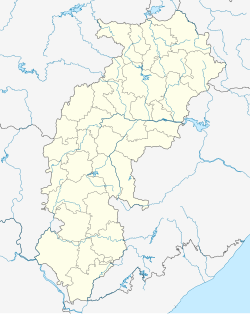Chaiturgarh
| Chaiturgarh fort | |
|---|---|
Lafagarh | |
| Part of Chhattisgarh Forts | |
| Korba district, Chhattisgarh | |
| Coordinates | 22°30′37″N 82°16′17″E / 22.5103°N 82.2714°E |
| Type | Hill fort / natural fortification |
| Height | 3,060 feet (930 m) |
| Site information | |
| Owner | archeological survey of india |
| Controlled by | Archaeological Survey of India |
| Condition | Protected ruins |
| Site history | |
| Built | 10th century CE |
| Built by | Raja Prithvideva I |
| In use | Temple and tourism |

Chaiturgarh or Lafagarh is a fort about 19 kilometres (12 mi) from Pali, Katghora tehsil, Korba district, Chhattisgarh, India, on the Korba–Bilaspur road. It is an Archaeological Survey of India protected monument. Chaiturgarh is one of the 36 forts of Chhattisgarh. Chaithurgarh is situated around 70 kilometres (43 mi) from Korba and 25 kilometres (16 mi) from Pali town.
Location
Chaiturgarh (also known as Lafagarh) is situated at a height of 3,060 feet (930 m) on a hill top. It is protected by strong natural walls and is considered as one of the strongest natural forts. Since it is protected by strong natural walls, only at some places walls have been built. The fort has three main entrances which are named as Menaka, Humkara, and Simhadwar.[1]
On the hilltop there is a plain area of about 5 square kilometres (1.9 sq mi) where there are five ponds. Three of these ponds have water all round the year. The hillocks of Chaiturgarh are famous for their natural beauty and the adventurous experiences it offers. Many types of wild animals and birds are found here.
Architecture
The famous Mahishasur Mardini temple is situated here. The idol of Mahishasur Mardini having 12 hands is installed in the sanctum sanctorum. Shankar cave is situated 3 kilometres (1.9 mi) away from the temple. The cave which is like a tunnel, is 25 feet (7.6 m) long. One can go inside the cave only by creeping since it is very small in diameter.

History
Archeologists[who?] consider it as one of the strongest natural forts.[citation needed] A Descriptive List of Inscriptions in the Central Province and Berar – dated in Kalchuri Era 933 (1181-82 CE) gives a long genealogical list of the Kalchuri kings. It mentions that there was a king in the family of the Haihaya who has eighteen sons. One of them was Kalinga whose son Kamala ruled over Tummana. Kamala was succeeded by Ratnaraja I and latter by Prithvideva I.Mughal emperor Akbar captured the fort in 1571 and mughals ruled 1628.[2] Chaiturgarh was constructed by Raja Prithvideva I.[3][4]
References
- ^ "Korba Chaiturgarh". Archived from the original on 10 January 2012. Retrieved 9 May 2012.
{{cite web}}: Unknown parameter|deadurl=ignored (|url-status=suggested) (help) - ^ Cultural Profile of South Kōśala. Retrieved 9 May 2012.
- ^ "Kharod inscription of Ratnadeva III". Retrieved 9 May 2012.
- ^ Chauley, G. C. (2004). Monumental Heritage of Orissa. Book India Pub. Co. p. 114. ISBN 978-81-85638-19-5.

